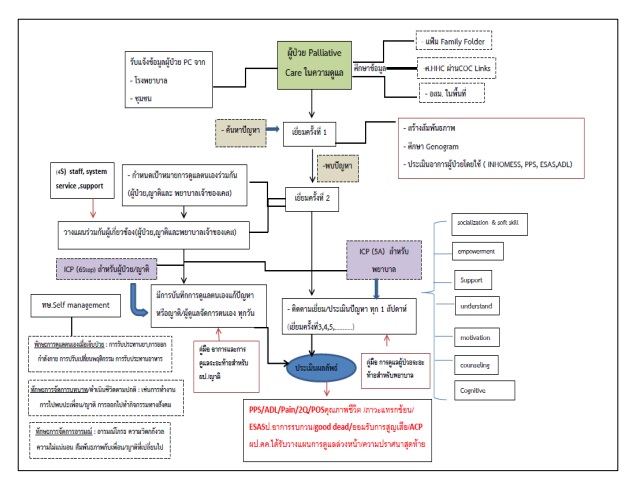การพัฒนาการจัดบริการพยาบาลกลุ่มผู้ป่วย/ผู้ดูแลผู้ป่วยแบบประคับประคอง ตามรูปแบบการจัดบริการพยาบาลในการสร้างเสริมการจัดการสุขภาพตนเอง ของประชาชน เครือข่ายจังหวัดสงขลา
คำสำคัญ:
รูปแบบการจัดบริการพยาบาลในการสร้างเสริมการจัดการสุขภาพตนเอง, ผู้ป่วย/ผู้ดูแลผู้ป่วยแบบประคับประคองบทคัดย่อ
การวิจัยเชิงปฏิบัติการนี้มีวัตถุประสงค์ 1) เพื่อจัดบริการพยาบาล ตามรูปแบบการจัดบริการพยาบาลในการสร้างเสริมการจัดการสุขภาพตนเอง กลุ่มผู้ดูแล/ผู้ป่วยแบบประคับประคอง 2) เพื่อศึกษาผลลัพธ์ของการจัดบริการพยาบาลในการสร้างเสริมการจัดการสุขภาพตนเองกลุ่มผู้ดูแล/ผู้ป่วยแบบประคับประคอง เครื่องมือที่ใช้ในการวิจัย ได้แก่ แบบบันทึกข้อมูล แนวคำถามการสนทนากลุ่ม แบบประเมินความสามารถในการจัดการตนเองของผู้ดูแล/ผู้ป่วยแบบประคับประคอง แบบประเมินผลลัพธ์ทางด้านการพยาบาล ผู้ป่วยแบบประคับประคอง และแบบสอบถามความพึงพอใจ วิเคราะห์ข้อมูลเชิงปริมาณโดยสถิติพรรณนา และข้อมูลเชิงคุณภาพ โดยการวิเคราะห์เนื้อหา (Content Analysis) ผลการวิจัย พบว่า
1. สภาพปัญหาและความต้องการจัดการพยาบาลในการสร้างเสริมการจัดการสุขภาพตนเองของผู้ป่วย/ผู้ดูแลผู้ป่วยแบบประคับประคอง ในหน่วยบริการปฐมภูมิเครือข่าย อำเภอเมือง และ อำเภอระโนด คือ 4 S (Staff, Service, System, Support) และ 6 ด้านคือ สภาพปัญหาสุขภาพ, ความเชื่อ, วัฒนธรรม, เศรษฐานะ, สภาพครอบครัว/ความพร้อมของผู้ดูแล การมีความร่วมมือของเครือข่าย, ความคาดหวังในการสร้างเสริมการจัดการตนเองของประชาชน
2. รูปแบบแนวทางการสร้างเสริมการจัดการตนเอง (Self-Management) สำหรับพยาบาล ครอบคลุม 5 A คือ 1) แนวคิดผู้ใช้บริการและครอบครัวที่มีต่อการดำรงชีวิต 2) ประเด็นปัญหา/ความต้องการในการดำรงชีวิต 3) แนวทางในการดูแลผู้ป่วยและครอบครัวรายบุคคล 4) เป้าหมายการดูแลระยะสั้น/ยาว 5) กิจกรรมที่ทำและผลลัพธ์ สำหรับผู้ป่วย/ผู้ดูแล ครอบคลุม 6 steps 1)การประเมินความสามารถในการดูแล (Access) 2) ตั้งเป้าหมายการดูแลผู้ป่วยร่วมกัน (Balance and Agree ) 3) วางแผนการดูแล/จัดการตนเอง (Create Collaboration Goals & Care Plan) 4) การพัฒนาทักษะและการสนับสนุน (Develop Skills & Support Nete Work) 5)วางแผนจัดการอาการเปลี่ยนแปลง/ฉุกเฉิน (Early Warning Signs & Acute Plan) และ 6) การนัดติดตาม (Follow Up)
3. ผลลัพธ์การจัดบริการประเมินจากพยาบาลวิชาชีพมีความพึงพอใจต่อรูปแบบฯ อยู่ในระดับความพึงพอใจปานกลางและมาก ร้อยละ 87 และ 89 ตามลำดับ และผลลัพธ์การจัดบริการเพื่อการสร้างเสริมการจัดการสุขภาพตนเอง ข้อมูลเชิงปริมาณพบว่า ผู้ป่วยแบบประคับประคอง มีค่าคะแนน Palliative Performance Scale (PPS) Score เพิ่มขึ้น 9 ราย (28.21%) Activities of Daily Living (ADL) เพิ่มขึ้น 12 ราย (37.50%) Edmonton Symptom Assessment System (ESAS) อาการรบกวนลดลง 18 ราย (56.25%) ไม่มีภาวะแทรกซ้อน และสามารถการจัดการตนเองได้ดี 22 ราย (68.75%) เสียชีวิตอย่างสมศักดิ์ศรี 2 ราย (6.25%)
เอกสารอ้างอิง
Atthawong, P. (2010). Competency of Professional Nurses Working in Community Health Centers, Songkhla Hospital Network. Social Medicine Documents Songkhla Hospital. (in Thai)
Chamchuri, D. (2019) Documents for Nursing Training Program to Promote Self-Management of Patients and Caregivers, March 26, 2019, Chaophya Park Conference Room, Bangkok.
Chanprasert, S., Chuamthong, T., & Sriplawong, S. (2016). The Development of a Palliative Nursing Service System Produces Good Outcomes for Patients and Their Families. Lopburi Cancer
Chatakan, W. (2015). Action Research. Surat Thani Rajabhat Journal, 2(1), 29-49.
Chirarattanawana, N., Wattanaamorn, S., & Rasmeepong, S. (2019). Community Participation in Health Promotion. Mahachula Academic Journal, 6(Special Issue), 365-381. (in Thai)
Creer, L. T. (2000). Self-Management of Chronic Illness. In Boekaerts, M., Printrich, P. R., & Zeidner, M. (Eds.). Handbook of Self-ฑegulation. pp. 601-629. San Diego, CA: Academic Press.
Creer, T. L., & Holroyd, K. A. (1997). Selfmanagement. In Baum, A., McManus, C., Newman, S., Weinman, J., & West, R. (Eds.). Cambridgehandbookofpsychology, Health, and Behavior. pp. 255-258. Cambridge: Cambridge University Press
Faculty of Medicine Mahidol University. (2015). Palliative Care. March 10, 2020 from https://www.rama.mahidol.ac.th/cancer_center/th/palliative-care
Haruthai, C., Leelawong, S., Atthachaiwat, A., & Suwankesawong, S. (2016). The Palliative Nursing Service System. Nonthaburi: Tawan Media.
Jaingam, N., Chusri, O., Pongkiatchai, R., & Marapen R. (2017). A Concept of Health Management for an Individual and Families Who Have Members with Chronic Diseases. Nursing Journal of the Ministry of Public Health, 27(3), 1-9. (in Thai)
Jensen, A. K. (2021). 7 Steps to Find the Perfect Pico. Evidence-Based Nursing Practice Guidelines. Retrieved March 10, 2020 from https://www.ebsco.com/sites/g/files/nabnos191 /files/acquiadam-assets/7-Steps-to-the-Perfect-PICO-Search-White-Paper-TH.pdf
Ketwang, W. (2019). A Study of the Result from Palliative Care Program in Terminal Stage Patients, Bangpahan Hospital, Phra Nakhon Si Ayutthaya Province. Journal of Preventive Medicine Association of Thailand, 9(2), 150-165.
Klunklin, A., Wichaikhum, O., Kunaviktikul, W., & Jaiwilai, W. (2015). Nurses’ Role on Developing Health Promotion Innovation in Northern. Nursing Journal. 42(Special Issue), 177-186. (in Thai)
Maharaj Nakorn Chiang Mai Hospital. (2008). Palliative Performance Scale for adult Suandok. March 10, 2020 from http://web.lpnh.go.th/lphc/file/pps.pdf
Mahatnirankul. S. (2016). Quality of Life Indicators. Department of Mental Health, Ministry of Public Health. March 10, 2020 from https://dmh.go.th/test/download/view.asp?id=17
Meenongwa, J. (2013). The Meaning and Management of Depression Among Persons Living with Uncontrolled Diabetes in North-east Thailand : A Phenomenological Study. Nursing Journal of the Ministry of Public Health, 23(1), 30-43. (in Thai)
Meenongwa, J., Kaewmart, P., Moongsin, S., wansree, U., Prapasano, Y., Erbboon, P., et.al. (2015). The Palliative Care for End-of-Life Patients in Northeast Socio-culture. Nursing Journal of the Ministry of Public Health, 24(2), 37-47. (in Thai)
Nakkhattara, S., Weerametacha, S., & Bosittipichet T. (2021). Prevalence of Pain and Outcomes of Home-Based Palliative Care in Patients with Advanced Cancer: Primary Care of Saraburi Hospital, Descriptive Study. Journal of Primary Care and Family Medicine, 4(2), 182-191 (in Thai)
Office of Nursing. (2016). The Palliative Nursing System of Ministry of Public Health. Nonthaburi: Tawan Media. (in Thai)
Office of the National Health Commission. (2021). Palliative Care for Thailand. March 10, 2020 from https://www.thailivingwill.in.th/sites/default/files/Operational_definition_Palliative_care.pdf
Pluemjai, T. (2020). Management Model for Nursing Service Quality Developingof Palliative Care in Songkhla Hospital. Journal of Prachomklao College of Nursing, Phetchaburi Province, 3(1) 73-94. (in Thai)
Ryan, P. & Sawin, K. J. (2009) The Individual and Family Self-Management Theory: Background and Perspectives on Context, Process, and Outcomes. Nursing Outlook, 57(4), 217-225.
Sapinan, L. (2013). Manual for the Use of the Palliative Care Outcomes Assessment (Palliative care Outcome Scale : POS). Chiang Mai: Klang Wiang Printing Co., Ltd.
Sapinan, L., (2013). Manual for the Use of the Palliative Care Outcomes Assessment. Chiang Mai: Klang Wiang Printing Company. (in Thai)
Sathira-Angkura, T., Haruthai, C., Leelawong, S., Kladjompong, P., Janta-Um-Mou2, U., Suwonkesawong, S. et.al. (2019). Nursing Curriculum Development to Promote Healthcare Self-managementin Patients and Caregivers. Journal of The Royal Thai Army Nurses, 20(3) 104-113. (in Thai)
Srichairatanakul, J. (2019). Boromarajonani College, Bangkok, Training Materials on Nursing to Promote Self-Health Management of Patients and Caregivers, Organized by the Nursing Division, Office of the Permanent Secretary, Ministry of Public Health 2019
Wattana, C., (2015). The Concept of Self-Management. Journal of Phrapokklao Nursing College, Chanthaburi, 26(Supplemental Issues), 117-127 (in Thai)
Wongsuwansiri, S., Chantaummao, U., Kladchompong, P. & Thepwong, C., (2019). Guidelines for Collecting Indicators for the Development of Nursing Service Quality. Fiscal Year 2020, Nonthaburi: Trawan Media.

ดาวน์โหลด
เผยแพร่แล้ว
ฉบับ
ประเภทบทความ
สัญญาอนุญาต
ลิขสิทธิ์ (c) 2022 วารสารเครือข่ายวิทยาลัยพยาบาลและการสาธารณสุขภาคใต้

อนุญาตภายใต้เงื่อนไข Creative Commons Attribution-NonCommercial-NoDerivatives 4.0 International License.
1. บทความหรือข้อคิดเห็นใด ๆ ที่ปรากฏในวารสารเครือข่าย วิทยาลัยพยาบาลและการสาธารณสุขภาคใต้ ที่เป็นวรรณกรรมของผู้เขียน บรรณาธิการหรือเครือข่ายวิทยาลัยพยาบาลและวิทยาลัยการสาธารณสุขภาคใต้ ไม่จำเป็นต้องเห็นด้วย
2. บทความที่ได้รับการตีพิมพ์ถือเป็นลิขสิทธิ์ของ วารสารเครือข่ายวิทยาลัยพยาบาลและการสาธารณสุขภาคใต้







